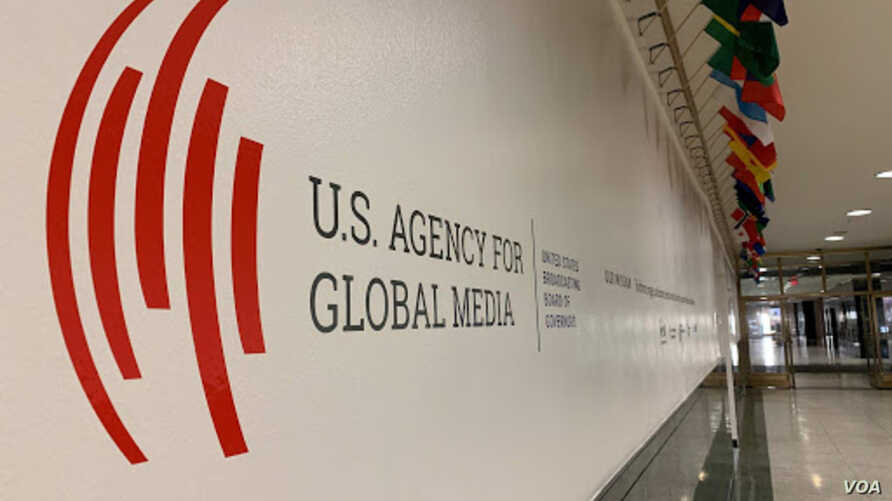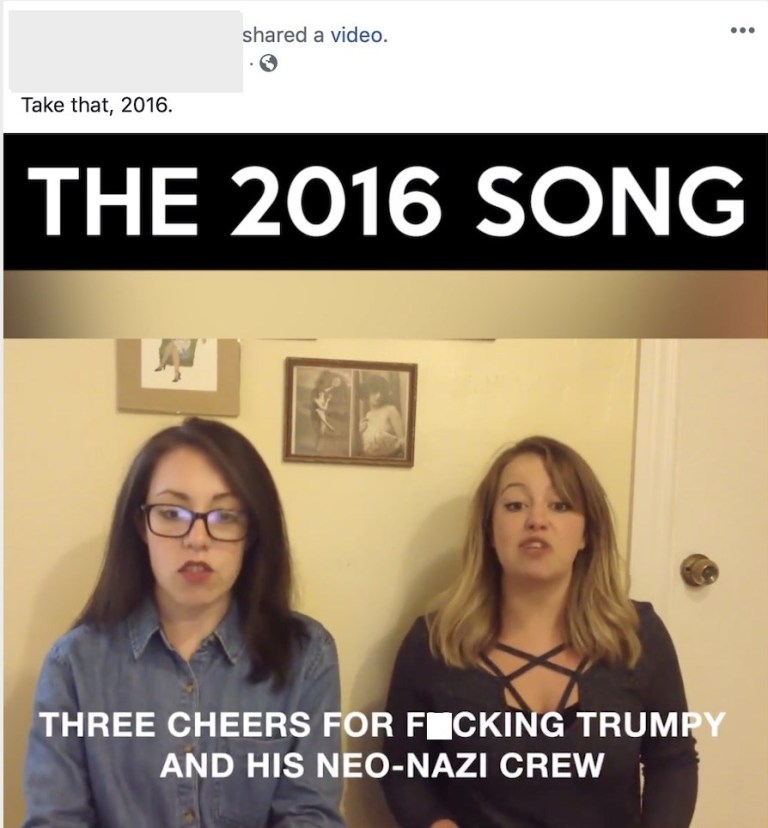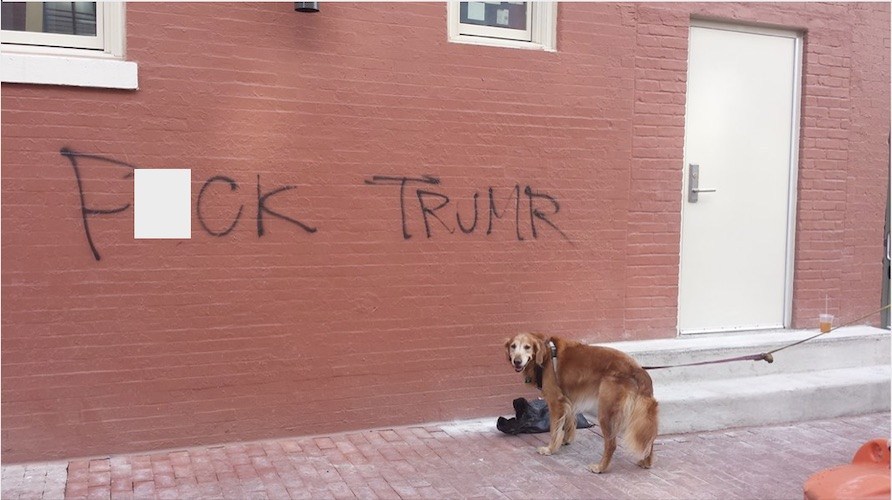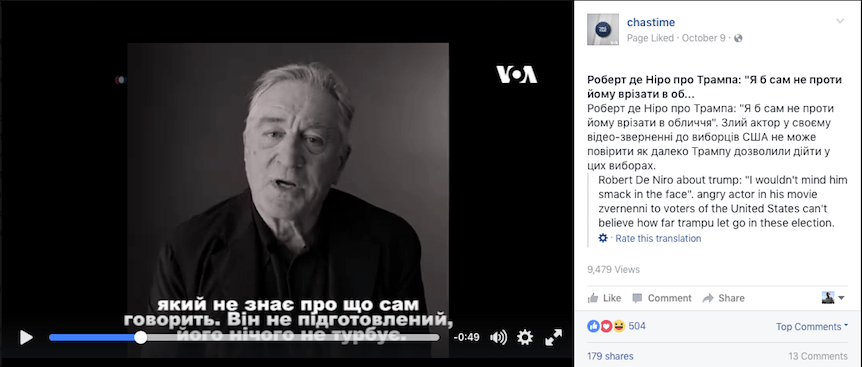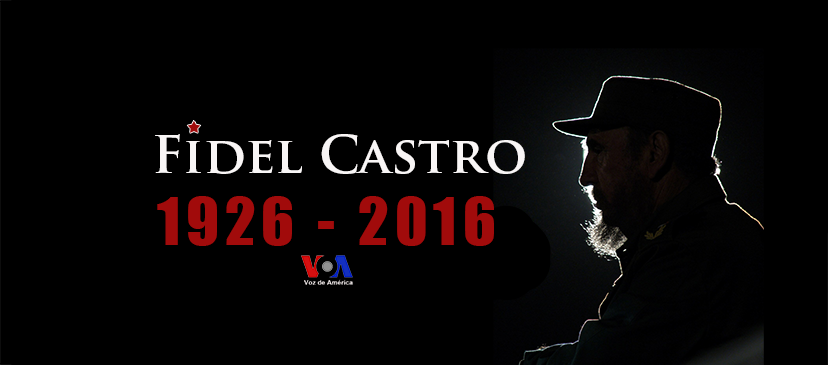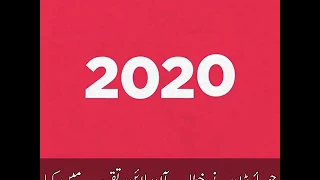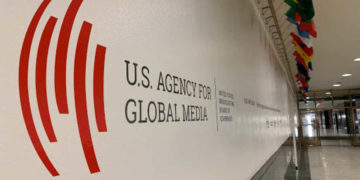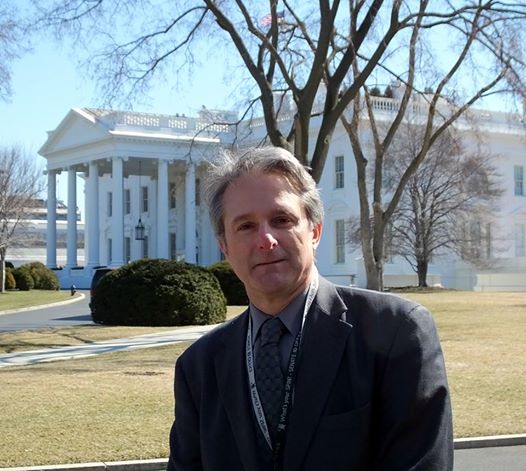From USAGM Watch Citizen Journalists: We are pleased to see the return of The Federalist, our longtime contributor and keen analyst of U.S. Agency for Global Media problems.
OPINION
Rumors, Myths, Untruths and Half-Truths
By The Federalist
Here we are, back again and dealing with the same old stuff when it comes to USAGM: the US Agency for Global Media. Maybe more like “Greater Mayhem.”
So, to set the tone, let us be reminded that this agency has earned the reputation for being one of, if not the worst agency, in the Federal Government. It has also been labeled “dysfunctional” by the former Republican Chairman of the House Foreign Affairs Committee and “practically defunct” by no other than former Secretary of State Hillary Clinton.
The agency must like these distinctions because they have done nothing to shed these labels for years if not decades. And so there it sits, lingering on via the budgetary life support provided by the Congress. At present, no one in the executive or legislative branch is interested in investing the time and resources needed to clean it up, move it somewhere else, and shut down most of its Washington bureaucracy. It is allowed to be a drain on the Federal budget: money ill spent on an agency that has only marginal impact or effectiveness abroad and possibly small but dangerous partisan domestic influence. It may be more correct to say that it has no impact or effectiveness in countries where it is really needed and which are important to the United States. Think of China, Iran, and Russia. It has some impact in a few countries thanks to some more courageous and better managed services in some of its entities. The world has changed dramatically, and this agency has fallen behind. So, in a world of trillion-dollar budgets, who cares? Let it languish as a backwater to much larger issues, both foreign and domestic, that confront the United States.
Nevertheless, the agency’s Washington bureaucracy tries to create an image of being relevant today when it certainly is far less than that. But you must understand the mindset on the Third Floor of the Cohen Building. No bureaucrat residing there can acknowledge the agency’s rather substantial shortcomings. That would be suicidal for USAGM and career-killing for any bureaucrat. So best to perpetuate the myths surrounding the agency.
With a new administration, it is no surprise that the agency is trying to defend itself in part with a USAGM document it calls “Rumors, Myths and Untruths” which we delve into:
Agency: “(UNTRUTH) USAGM programs are just propaganda.” It goes on to say, “No. The mission of USAGM and its networks is to broadcast accurate, balanced and news and information to an international audience. The mission to promote freedom and democracy is achieved through journalistic integrity…USAGM broadcasters know…that their listeners are not interested in propaganda.”
Reality: It is long been chronicled through the BBG Watch and now USAGM Watch website where the agency has fallen off the rails in its program content. It has embraced the bias now a regular part of major media. This is particularly the case with the Voice of America (VOA) newsroom which is little more than a laager for Leftists who went out of their way to present former president Trump in the most negative light possible, jumping on the bandwagon to portray him through Facebook posts of one VOA reporter Nazi symbols or the male genitalia. It also presented program content favorable to then-candidate Joe Biden. The list goes on and on.
And there is this notion of promoting “freedom and democracy.” Nowhere in the VOA Charter is this described as the agency’s mission. Saying so is blundering into a minefield. And agency officials haven’t the requisite knowledge and expertise to understand that it is a strategic blunder. Case in point: Burma (Myanmar). Though not a hot topic domestically in the US, it has substantial international coverage particularly in Asia. The civilian government has been overthrown by the Burmese military. The confrontation has been steadily ratcheting up with the army responsible for killing civilians. In addition, there is a separatist movement taking on the Burmese military in areas populated by disaffected minorities. The United States has made a bold claim of sanctions against the Burmese military, but the Chinese government is supporting the Burmese military and is certainly working around any actions by the United States.
“Promoting freedom and democracy” is nothing but sloganeering. If it detracts from providing news, information and opinions, it is not doing much for the people on the ground in Burma or anywhere else where authoritarian governments with well-armed military and police are in control. It is rather doubtful that anyone listening to a VOA broadcast is interested in sloganeering, which in its net effect is propaganda. What audiences want is news and information, which their governments censor–not just any CNN-type US news–and they want to hear opinions, including their own, which their governments block from being expressed. Filling this need provides sufficient news combined with moral support.
Agency: “(MYTH) It is against the law to view USAGM content in the United States.”
The agency claims that USAGM “can now make (their) content available in broadcast quality upon request within the United States.” The agency goes on to cite the controlling legislation, the Smith-Mundt Act (1948) which was many years later amended as the “Smith-Mundt Modernization Act.”
Reality: But here is the rub: this is something of a semantic declaration. Why? Because anyone with a computer can view and/or listen to agency content anywhere in the United States. No request needed. Sometimes with this agency it is not what it says, it is what it does not say. Go on VOA websites and you have all the content the agency is generating. You may also be able to listen in on what the agency is broadcasting or hear pre-recorded program material. One often-cited example is of agency program content specifically aimed at the Somali community in Minneapolis/St Paul as an attempt to counter anti-American sentiment.
But wait! There is more! Agency content is also available to anyone in the US on Facebook and YouTube, among other sites. People in the immigrant or ethnic populations in the United States know this. And the agency does not hide the fact.
So, what you have here is an agency disingenuous half-truth. It spells out what the law says but as the saying goes, the law has been “overtaken by events” and certainly by technology which puts agency’s content, including any that is biased and partisan, at the fingertips of anyone inside the United States.
Agency: “(RUMOR) The USAGM can focus its broadcasting on the United States.”
Reality: We do not know where this alleged rumor originated. It may be a consequence of the availability of agency programs online via the agency’s own websites or via Facebook and YouTube. Know too that agency personnel maintain accounts on Twitter, Instagram and LinkedIn and most of their followers, as far as we can tell, are in the United States. They often repost and comment on VOA news reports, some of which were shown to be in violation of the VOA Charter.
Regardless, the agency is indeed charged with broadcasting programs for foreign audiences, but this requirement has also been overtaken by technology so that its program content is available almost anywhere.
Agency “(UNTRUTH) USAGM has an unlimited budget.”
Reality: For once, the agency is correct. It does not have an unlimited budget. Its budget originates in the budget proposal submitted to the Congress by the White House/Office of Management and Budget. As noted, it is presented to the Congress where it goes through the appropriation and authorization process of hearings and reconciliation of House and Senate versions of its appropriation bills. When an authorization bill is finally crafted, it is submitted to the White House, often part of larger budget bills for presidential approval.
The agency states that its most recent budget request is for $628 Million dollars. Once again, in a world of competing priorities in a multi-trillion-dollar budget process it is ironic that this amount of money would appear insignificant. And one speculates what the agency’s budgetary future may be with the enormous spending requests by the Biden administration increasing the national debt exponentially. Anything could have a negative impact on the agency’s budget in the current environment. And we emphasize negative impact. It is not likely that the agency would see enormous budget growth after adjustments for inflation in the near future. In short, the Biden administration has made clear in general terms what its budget priorities are. US international broadcasting seems way, way down the list.
Agency: “(MYTH) U.S. global media is unnecessary when there are CNN and Sky Channel.”
Reality: This is not so much a myth as it is something that falls under the category of impact and effectiveness. Media technology and growth has been exponential in the 21st century. USAGM is no longer one of a few international broadcasters. With satellite technology, program content from a variety of providers is almost universal. Even in places where advanced technologies may not be readily available, local and regional broadcasters fill the void. The agency notes that local media may be government-controlled and subject to censorship, but the same applies to USAGM broadcasts, with the additional element of the reporters’ and editors’ own unchecked partisan bias. Just how much of the agency’s program content is reaching intended audiences and to what degree? The agency claims audiences in the millions. But these claims, unilateral in nature, have not been independently verified. The agency expects the beholder to accept the numbers as fact. Let’s just say that such unilateral declarations are suspect. As we have noted, no one in the USAGM management is ever going to admit that the agency real audience claims quite probably don’t live up to the hype. They try to hide the fact that much of the online audience for VOA English-language content is in the United States and can have some impact on U.S. politics.
As noted in the past, these claims can be weighed against the agency’s presence on Facebook and YouTube where the number of views, likes and dislikes are anemic at best. This is especially significant when viewed in the context of a global population of 7-Billion people a good portion of which lays in target areas of USAGM programming efforts. CNN and Sky Channel are only a small portion of a much larger media environment. In our view, USAGM is increasingly a smaller part of that environment.
Agency: “(UNTRUTH) USAGM entities such as VOA and RFE/RL often duplicate efforts by broadcasting in the same language.”
Reality: This issue goes back to the very beginnings of both VOA and the other entities that are known collectively as “the grantees” chartered under separate legislation. The origins of this issue go back to the days when the agency was predominantly a radio-only broadcaster. Once again, it is an issue that has been overtaken by events most noticeably by technology. Radio is no longer the sole program technology available to the agency. Current technology allows program content to be accessed via radio, television/satellite and the Internet. Essentially, the agency likes to claim that the grantees are “surrogates” for local media or in place of government-controlled media. Does it really justify parsing the programming out in this manner? The answer at this juncture is probably no for most of the world. While the grantees may wade into regional news more than VOA, the reality is that regional news is often co-mingled with international news. It is inescapable. And the issue of accessibility is no different for VOA or the grantees. Both can be blocked. Depending on the locality, one might be blocked more than the other. But we should remember that this is the 21st century. Every government around the world knows who funds these broadcasters. Whether it is RFA Chinese or VOA Chinese, either one is equally unpopular with the Beijing government unless one is far better than the other in exposing local abuses of power and corruption.
Last But Not Least:
What is the firewall?
Ah, yes. The alleged “firewall.”
One must distinguish between intent and reality.
There are two important statements the agency makes in this document that are worth examining:
“The firewall prohibits interference by U.S. government officials, including the USAGM’s Chief Executive Officer, in the objective, independent reporting of news by USAGM networks (VOA, RFE/RL, RFA, MBN and Radio/TV Marti) thereby safeguarding the ability of USAGM journalists to develop content that reflects the highest professional standards of journalism, free from political interference.”
We know from direct observation that “the highest professional standards of journalism” is a crock. Routinely, the agency allegedly conducts “classes” regarding best practices with its journalists. Apparently, there is a problem here. And it is a problem that is ongoing as some journalists inside VOA in particular think they can operate in the same manner as what they see on CNN or MSNBC.
As far as the Chief Executive Officer, that person answers to someone whether it be inside the White House or the Department of State. That person may encounter a situation that directs the person to include official government content into agency programming. At that point, the Chief Executive Officer has a choice to make: do it or resign. It has happened before many years removed from the present day. But it can happen again.
Next:
“…the firewall is critical to ensure that USAGM journalists and editors can make the final decisions on what stories to cover, and how they are covered.”
In an agency that has demonstrated political bias in its program activities this walks right into the area of censorship by commission and omission. Certainly this was well on display during the Trump administration as reported numerous times on BBG Watch and USAGM Watch.
But what is perhaps more important is that the concept of a “firewall” has been hijacked and corrupted by so-called agency “journalists.” This is not CNN or MSNBC. This is a federal agency. And what should be uppermost is: ACCOUNTABILITY. The “firewall” has been subverted in its intent by those inside the VOA newsroom to mean ZERO ACCOUNTABILITY. That is a big problem. And what is even a larger problem is that no one in the upper reaches of the agency’s bureaucracy and even among its senior editors and program managers is prepared to hold its “journalists” accountable.
All these things make the agency less of an asset and more of a liability. They define where the agency is at.
The Federalist
April 2021
USAGM Watch Commentary
We find the U.S. Agency for Global Media post “Rumors, Myths and Untruths” to be so propagandistic, poorly-written and deceptive that we want to re-post it before it may disappear from the USAGM website.
U.S. AGENCY FOR GLOBAL MEDIA POST
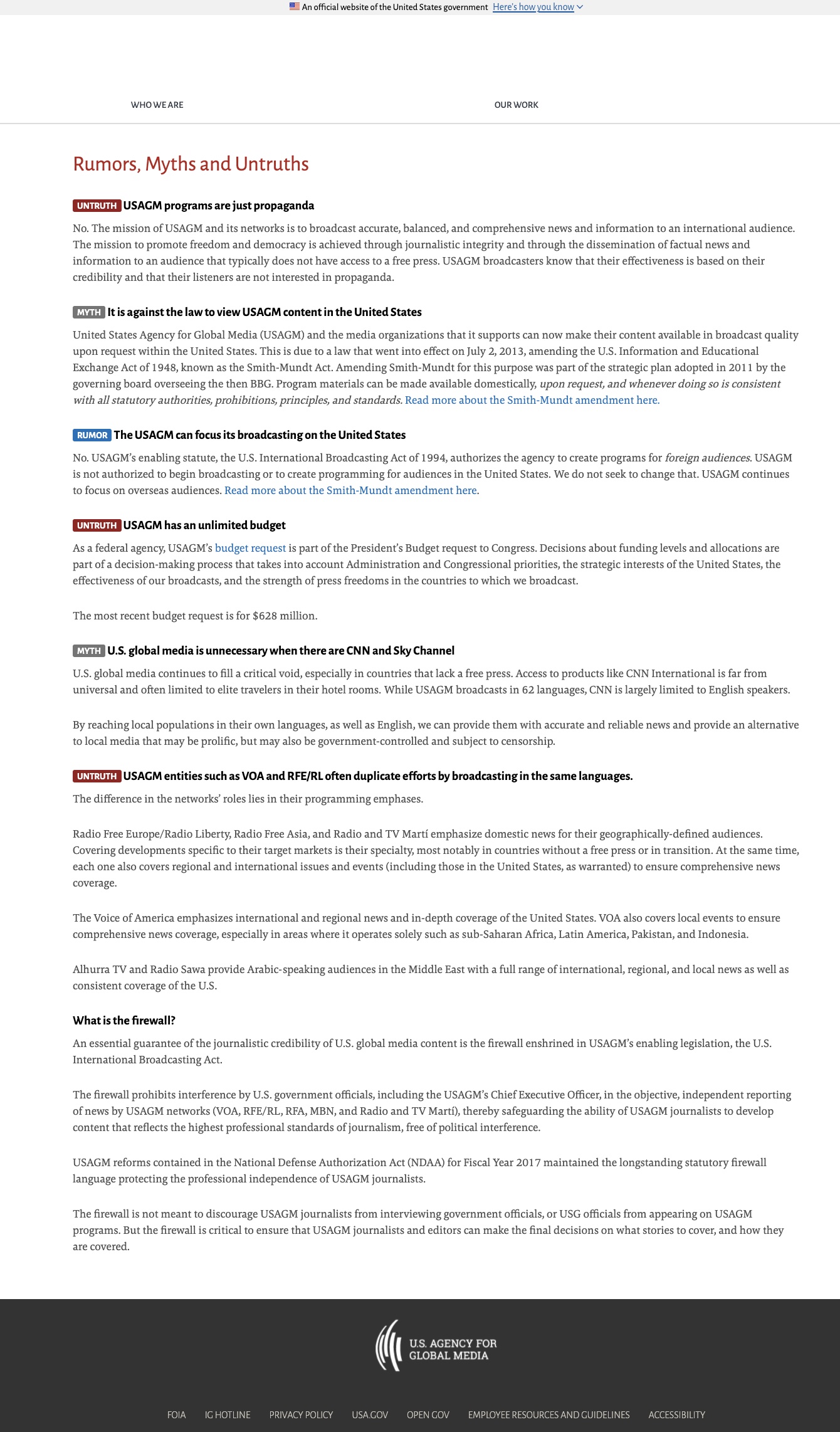
Rumors, Myths and Untruths
UNTRUTH USAGM programs are just propaganda
No. The mission of USAGM and its networks is to broadcast accurate, balanced, and comprehensive news and information to an international audience. The mission to promote freedom and democracy is achieved through journalistic integrity and through the dissemination of factual news and information to an audience that typically does not have access to a free press. USAGM broadcasters know that their effectiveness is based on their credibility and that their listeners are not interested in propaganda.
MYTH It is against the law to view USAGM content in the United States
United States Agency for Global Media (USAGM) and the media organizations that it supports can now make their content available in broadcast quality upon request within the United States. This is due to a law that went into effect on July 2, 2013, amending the U.S. Information and Educational Exchange Act of 1948, known as the Smith-Mundt Act. Amending Smith-Mundt for this purpose was part of the strategic plan adopted in 2011 by the governing board overseeing the then BBG. Program materials can be made available domestically, upon request, and whenever doing so is consistent with all statutory authorities, prohibitions, principles, and standards. Read more about the Smith-Mundt amendment here.
RUMOR The USAGM can focus its broadcasting on the United States
No. USAGM’s enabling statute, the U.S. International Broadcasting Act of 1994, authorizes the agency to create programs for foreign audiences. USAGM is not authorized to begin broadcasting or to create programming for audiences in the United States. We do not seek to change that. USAGM continues to focus on overseas audiences. Read more about the Smith-Mundt amendment here.
UNTRUTH USAGM has an unlimited budget
As a federal agency, USAGM’s budget request is part of the President’s Budget request to Congress. Decisions about funding levels and allocations are part of a decision-making process that takes into account Administration and Congressional priorities, the strategic interests of the United States, the effectiveness of our broadcasts, and the strength of press freedoms in the countries to which we broadcast.
The most recent budget request is for $628 million.
MYTH U.S. global media is unnecessary when there are CNN and Sky Channel
U.S. global media continues to fill a critical void, especially in countries that lack a free press. Access to products like CNN International is far from universal and often limited to elite travelers in their hotel rooms. While USAGM broadcasts in 62 languages, CNN is largely limited to English speakers.
By reaching local populations in their own languages, as well as English, we can provide them with accurate and reliable news and provide an alternative to local media that may be prolific, but may also be government-controlled and subject to censorship.
UNTRUTH USAGM entities such as VOA and RFE/RL often duplicate efforts by broadcasting in the same languages.
The difference in the networks’ roles lies in their programming emphases.
Radio Free Europe/Radio Liberty, Radio Free Asia, and Radio and TV Martí emphasize domestic news for their geographically-defined audiences. Covering developments specific to their target markets is their specialty, most notably in countries without a free press or in transition. At the same time, each one also covers regional and international issues and events (including those in the United States, as warranted) to ensure comprehensive news coverage.
The Voice of America emphasizes international and regional news and in-depth coverage of the United States. VOA also covers local events to ensure comprehensive news coverage, especially in areas where it operates solely such as sub-Saharan Africa, Latin America, Pakistan, and Indonesia.
Alhurra TV and Radio Sawa provide Arabic-speaking audiences in the Middle East with a full range of international, regional, and local news as well as consistent coverage of the U.S.
What is the firewall?
An essential guarantee of the journalistic credibility of U.S. global media content is the firewall enshrined in USAGM’s enabling legislation, the U.S. International Broadcasting Act.
The firewall prohibits interference by U.S. government officials, including the USAGM’s Chief Executive Officer, in the objective, independent reporting of news by USAGM networks (VOA, RFE/RL, RFA, MBN, and Radio and TV Martí), thereby safeguarding the ability of USAGM journalists to develop content that reflects the highest professional standards of journalism, free of political interference.
USAGM reforms contained in the National Defense Authorization Act (NDAA) for Fiscal Year 2017 maintained the longstanding statutory firewall language protecting the professional independence of USAGM journalists.
The firewall is not meant to discourage USAGM journalists from interviewing government officials, or USG officials from appearing on USAGM programs. But the firewall is critical to ensure that USAGM journalists and editors can make the final decisions on what stories to cover, and how they are covered.
END OF USAGM POST “MYTHS, RUMORS and UNTRUTHS” COPIED APR. 15, 2021


